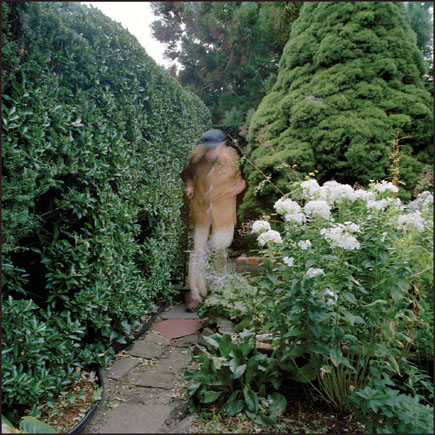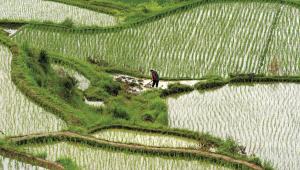Personal Project; The Poet And The Photographer; A Photographer Translates A Poet’s World Page 2
"I learned that every part of the garden was animated. Stanley would refer to one tree as a `member of my family.' Every part of the garden lives and breathes and I remember picking up a random little gray rock one day and thanked God I didn't throw that rock away.
"I had seen certain gestures," Crawford Samuelson recalls. "He would often have his hands behind his back, beautiful hands, long delicate fingers. This is a posture one doesn't see here often in America. I wanted to make this photograph but often I was in the wrong place or what surrounded him did not work visually."
 |
|
|
Moving in to photograph those hands covered with dirt and held against his
lower back resulted in one of the most admired images in the collection--a
portrait in the truest sense and for Crawford Samuelson it was the whole story.
"I had often seen Stanley hold onto a particular tree," Crawford
Samuelson recalls. "It was a beautiful gesture. It took me two years to
actually photograph that. If I missed the moment I would have to wait for another
season, a whole year."
Three years ago Crawford Samuelson photographed Kunitz as he stood before a
tree he had planted 50 years before. The Alberta Spruce had encroached on the
garden and he had decided to have it felled. She photographed his melancholic
expression as he watched the process and a few moments later shot again as he
was replanting the remains of the tree to make sure it would grow again.
"He was usually different from what I expected," Crawford Samuelson
says. "On the last day of the season I might think he would be sad but
there he was scattering seeds with great joy and abandon. My camera was out
at all times and I never knew what might transpire in the landscape or with
Stanley. It was always a surprise. There would be one thing and I would go with
my first instinct, which usually was a significant aspect of the garden on that
particular day. If I tried to push it to two things and be greedy it never panned
out. There was just the sense that if I tried too hard I would get nothing.
I realized that there was just a certain amount and then the photograph would
become boring. This is what I learned and try to bring with me into my new work.
There must be economy, a sense of not being greedy.
"On a hit and run basis you go in and grab a new subject because you don't
always know what is there. Over four seasons here everything had time to `bake.'"
Crawford Samuelson worked primarily in medium format, mostly using a Hasselblad
and a wide lens for this project. "I decided early on to use available
light and on occasion used a monopod. I wanted the movement that was truly a
part of this seaside garden series where the ocean breeze moved things continually.
"I deliberately did not talk to Stanley about gardening for a couple of
years because I didn't want to make illustrations. I came into this photo
session open and ignorant and waited to find my own way and to discover his
relationship with the garden. I learned the essentials of just being there,
the rhythm and movement of the wind coming across from the bay and how sometimes
the trees might be blowing while the flowers were still. Almost all of the photographs
have movement and it is one of the essentials in realizing how things change.
"Coming through the pockets of the garden and maintaining the mystery
was my aim and my conclusion was that I was trying to photograph a life.
"In the end it occurs to me that photography's success is almost
in its failure because it is a two-dimensional image. The image is not my friend
Stanley and in that sense it is never good enough. The journey is about letting
go and that may be where you do your best work."
Turning The Soil
"I can scarcely wait till tomorrow when a new life begins for me, as it
does each day, as it does each day."
--Stanley Kunitz
- Log in or register to post comments

















































